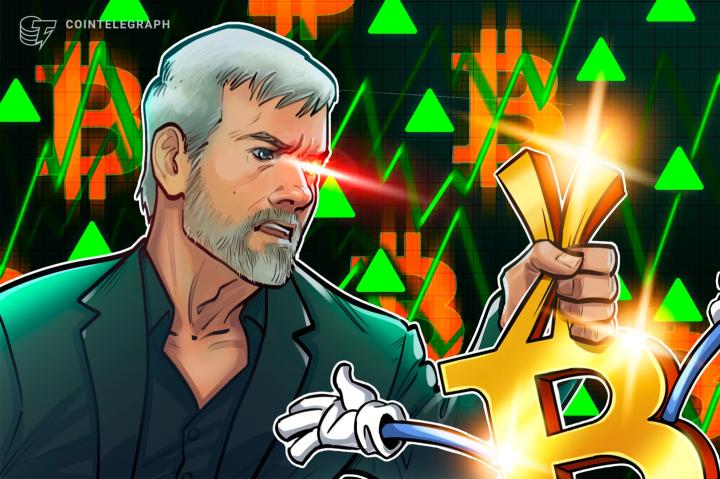Author: Climber, Jinse Finance
Since the upgrade of Ethereum Shanghai in April this year, LSD WAR has become more and more intense. Liquidity staking allows users to maximize the use of capital income, and various DeFi projects continue to launch product Lego to compete for market share. Under this market trend, Pendle has gained a lot, and its TVL has increased by nearly 10 times since the beginning of the year.
Pendle is a decentralized yield trading protocol where users can execute various yield management strategies. Shortly after listing on Binance in early July, it received investment from Mantle Ecological Fund and Binance Labs. Recently, Pendle announced that it will use MakerDao's sDAI and Flux Finance's fUSDC in its first RWA product.
RWA is one of the hottest crypto tracks at the moment. While everyone is still looking forward to when Pendle will add it to the camp, these two types of investment portfolios have been launched simultaneously. And in just five days, its TVL has exceeded 15.3 million US dollars, and the sDAI interest rate trading LP pool surpassed the GLP pool to become the second largest TVL pool on pendle.
1. Fundamental analysis
LSDfi is a series of LSD-based agreements, including not only DEX and lending agreements, but also more complex agreements built using LST attributes, such as Baskets agreement, stable currency, income strategy, etc.
Pendle belongs to the encryption asset income strategy agreement. Through the use of DeFi products provided by it, users can increase the yield exposure in the bull market, and hedge the downward yield in the bear market, so as to maximize the income.
The Pendle project system is mainly composed of three parts, revenue tokenization, AMM, and vePENDLE. Through this system, Pendle can package the user's encrypted assets into a standardized income token SY, and SY can be further divided into principal and income components, namely PT (principal token) and YT (yield token). Both PT and YT can be traded through Pendle’s AMM.
vePENDLE is a functional token used for Pendle governance, and users can obtain it by staking PENDLE.
With the help of the LSD track, Pendle's further product design - revenue maximization mechanism has attracted a large number of users. According to DeFiLlama data, Pendle TVL is US$140 million, with a maximum increase of 1,000% since the beginning of this year.

However, the staking revenue track has been around for a long time. After the LSD became hot, there are many strong projects that have taken advantage of this transformation, such as Lido, MakerDAO, RocketPool, Stkr (Ankr), Stakewise and so on. In comparison, the Pendle project has been established for a shorter period of time. Even if the benefits provided are slightly better, it still faces development bottlenecks in the fierce competition for market share.
In the context of the global economic recession, the deep bearishness of the encryption market, and the rise in U.S. bond interest rates, the RWA track is favored by investors who pursue stable returns with low risks.
At present, the RWA track is developing rapidly. In addition to the participation of established crypto projects, traditional financial institutions are also accelerating their entry.
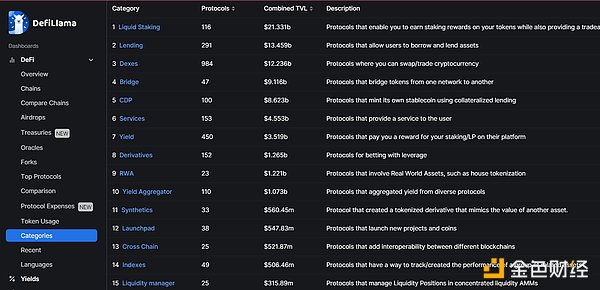

In DeFiLlama’s breakdown of the DeFi track category, the LSD sector TVL ranked first with $21 billion, nearly double the lead in the lending sector. The RWA sector has grown rapidly, especially since April 8 this year. Its TVL has risen rapidly from US$150 million to US$1.2 billion as of the time of publication, an increase of nearly 900% in four months.
The most valuable sector in the DeFi track has already had a share of the cake, but Pendle obviously has a greater appetite and has extended its tentacles to another RWA sector that is growing the fastest and has huge potential.
2. Agreement mechanism
In DeFi, users put funds into the income mining pool and can obtain APY that fluctuates over time. For example, the DAI pledged in Compound is represented as cDAI; the ETH pledged in Lido is represented as stETH.
However, the generation of these passive income depends on the length of the pledge time, and the expected income is also bound in disguise, which cannot be maximized. Even through revolving loans, not only the risk will be increased, but the gas fee will also be high.
Pendle not only unbundles users' principal and income, but also allows users to have more trading control options for the use of income while ensuring that they have fixed income.
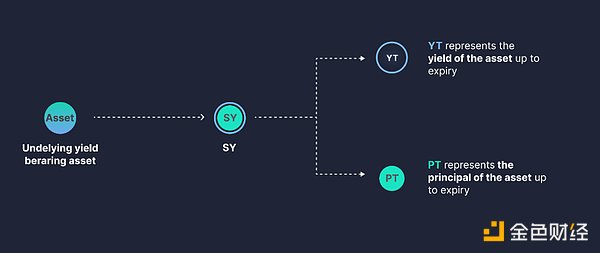
Specifically, Pendle packages LSD\LST into the platform's native SY, and then splits it into PT (principal token) and YT (income token), that is, income tokenization.
Users can buy and sell PT on Pendle AMM, and its price is generally determined by market supply and demand. Since PT does not include the rate of return part, the PT corresponding to the purchased asset is relatively cheap, that is, purchased at a discount. Therefore, the product cannot be equivalent to the original asset until it reaches maturity.
For example, suppose there is a stETH pool in Pendle with a term of 1 year, then PT stETH holders can redeem stETH at a ratio of 1:1 after 1 year.

It is worth noting that although PT can only redeem the underlying asset when it expires, users can also choose to sell it in advance according to their own and market conditions.
YT (yield token) can be traded in the same pool as PT (principal token) on Pendle AMM. At the same time, as the income part of the pledged principal, YT can be traded at any time.

If investors believe that the average APY in the future will be higher than the current market implied APY, they can choose to long. The future average APY can refer to the current underlying APY, that is, the APY generated in the underlying protocol. If all conditions remain exactly the same from now until expiration, the future APY should be the same as the base APY.
Specifically, when the implied yield > the underlying APY, the long-term yield APY will be negative. This means that, assuming the underlying APY remains constant, the cost of buying YT will be higher than the average future rate of return collected, so it is better to sell YT.
However, even when Implied APY < Base APY, if a user purchases YT with a positive long-term APY, the average future APY may be lower than the transaction's Implied APY, resulting in a loss.
Therefore, the user's long position profit depends on the holding or increase of income.
The trading foundation of PT and YT comes from Pendle's unique AMM mechanism design, which is a unilateral trading pool. That is, through built-in automatic routing, anyone with any major asset can trade PT and YT on Pendle through a single liquidity pool. YT.

The AMM curve shifts to account for yield over time and narrows the price range for PT as it approaches maturity. By pooling liquidity into a narrow, meaningful range, the capital efficiency of trading yields increases as PTs approach maturity.
The liquidity pool in Pendle V2 is set to PT/SY, such as PT-aUSDC / SY-aUSDC. Swap PT is a simple process of swapping between 2 assets in a pool, while swap YT is enabled via flash swap in the same pool.
In addition, the design of Pendle V2 also ensures that the problem of Impermanent Loss is negligible. Pendle's AMM mitigates time-related Impermanent Loss by moving the AMM curve, pushing the price of PT toward its underlying value over time, thereby allowing the natural price appreciation of PT.
3. Access to RWA: open source and efficiency improvement
According to data from Pendle’s official website, the TVL of the new RWA pool is growing rapidly. Only one week after its launch, the TVL of PT sDAI Pool is 13.7 million US dollars, and the TVL of PT fUSDC Pool is 2.69 million US dollars.
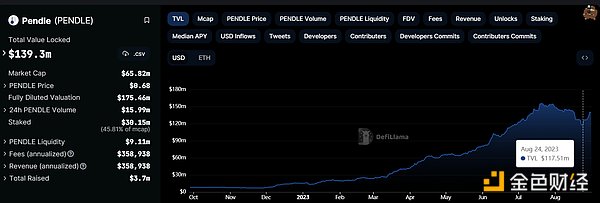
From the perspective of the overall trend of Pendle TVL, it has stabilized after reaching a peak of 155 million US dollars on July 20, and has gradually declined. However, after the announcement of the addition of RWA products, it began to enter the rising range. It is worth noting that the encryption market at this time is still in a sideways stage.
Such a significant increase in liquidity comes from the high rate of return that Pendle has set for PT sDAI Pool. It can be seen from the figure that the fixed APY of the sDAI pool is 3.74%, and the long-term yield APY is 32.4%.

In addition, by providing liquidity to the sDAI pool, users can not only obtain part of the fixed income exposure, but also obtain the mixed income of sDAI local yield and additional rewards: sDAI DSR + transaction fees + sDAI fixed income (from PT-sDAI) + PENDLE motivation.
Previously, Spark Protocol's DSR has been reduced from 8% to 5%, but this high interest rate is still subsidized by MakerDAO income. And, as an actual EDSR mechanism, if USDT fluctuates strongly or MakerDAO’s income decreases, the actual income of users may be lower than the rate of return provided for sDAI products in Pendle.
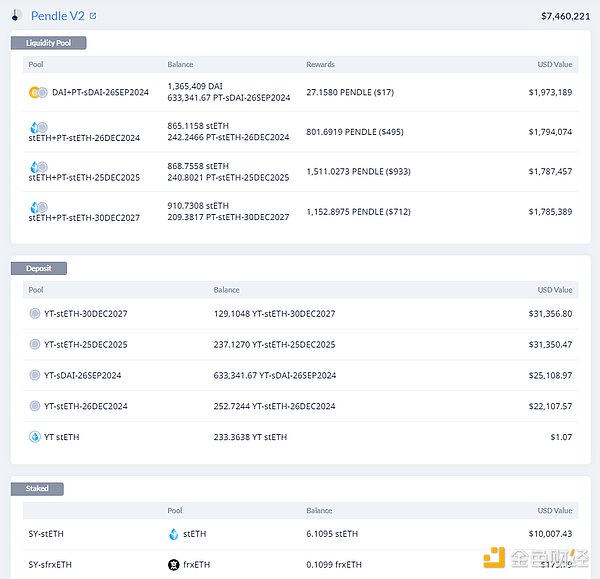
The new RWA pool also attracted some whale to join. The wallet address 0xa8321f92e4589f7754831cac607180372197b7f6 with a total value of 7.7 million US dollars deposited 2 million US dollars in Pendle’s sDAI pool.
Another wallet address 0x18f7a7ad23163c5ea7d5c059c1a98c3ce57cb5c0 with a total value of $2.5 million deposited $1 million. In addition, there are not a few other accounts with large deposits.
epilogue
The lack of liquidity under the crypto bear market has become a difficult problem for all market participants. How to maximize the use of funds and reduce risks is the current demand of most investors. After LSD releases the funds pledged by users, it needs to further generate greater efficiency, and Pendle provides a new option for this.
The continuous expansion of the RWA track has also allowed institutions and investors to see a broader market. The tokenization of U.S. debt is just a pilot. In the future, it is believed that more real-world assets will become tokenized financial products. Therefore, Pendle's timely shot also gave it the ticket to occupy a larger market share in the future.






